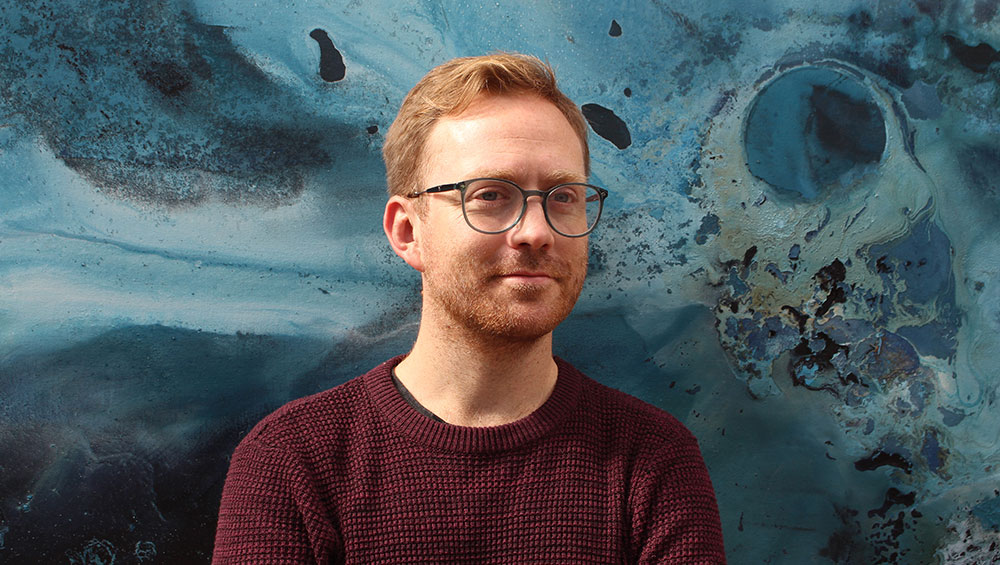
by DAVID TRIGG
Filled with tragedy, brutal spectacle and a cast of tormented characters on the brink of disintegration, Tom de Freston’s art explores the darker realms of human experience. His unsettling paintings, which collide figurative and abstract elements, hover between horror and beauty, life and death, the past and the present. But whether drawing inspiration from the history of painting, Shakespearean tragedy, ancient myths, contemporary geopolitics, acts of terrorism, or his own experiences of trauma, the Oxford-based artist is consistent in his desire to find hope amid turmoil.
Often working in series, De Freston (b1983, London) has spent the last 12 years creating an ambitious body of work that tackles universal themes of human suffering and endurance. His ongoing series of Raft paintings reinterpret Théodore Géricault’s The Raft of the Medusa (1819), an extraordinary painting that has significantly influenced his work and his understanding of the relationship he had with his late father. Scenes from Shakespeare’s plays are recast for the post-9/11 era in his Scavengers series (2011), while his Poor Tom paintings (2015-2016) riff on King Lear’s Dover Cliff scene to explore the liminal space between living and dying. In 2017, his gruesome Truth Tellers series responded to the horrific Manchester Arena bombing of the same year. These images, which explore the collective trauma surrounding the attack, appear like charred fragments of a bomb blast; mouths, eyes and noses are glimpsed amid violent accumulations of dragged and splattered paint.
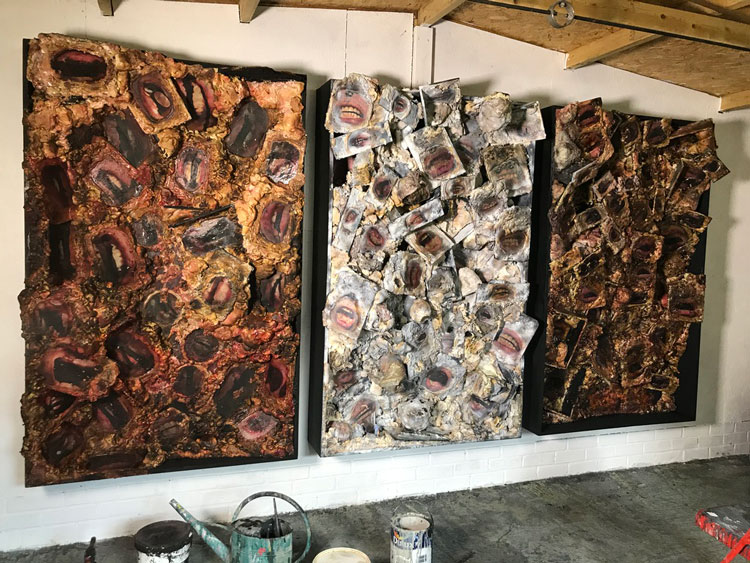
Tom de Freston. I Saw This, 2019-20. Courtesy the artist.
Similar imagery appears in the artist’s most recent project, I Saw This (2019-20), a collaboration with professor Ali Souleman, a blind Syrian academic at the University of Oxford. Souleman lost his sight in a bomb attack in 1997 while waiting at a bus stop in Damascus. The subsequent civil war forced him to flee Syria, separating him from the stability of a place he once called home. His startling story provides a unique insight into the Syrian conflict, but, more significantly for De Freston, it is a powerful personal testimony of living with the trauma of a debilitating physical injury and the psychological pain of geographical displacement.
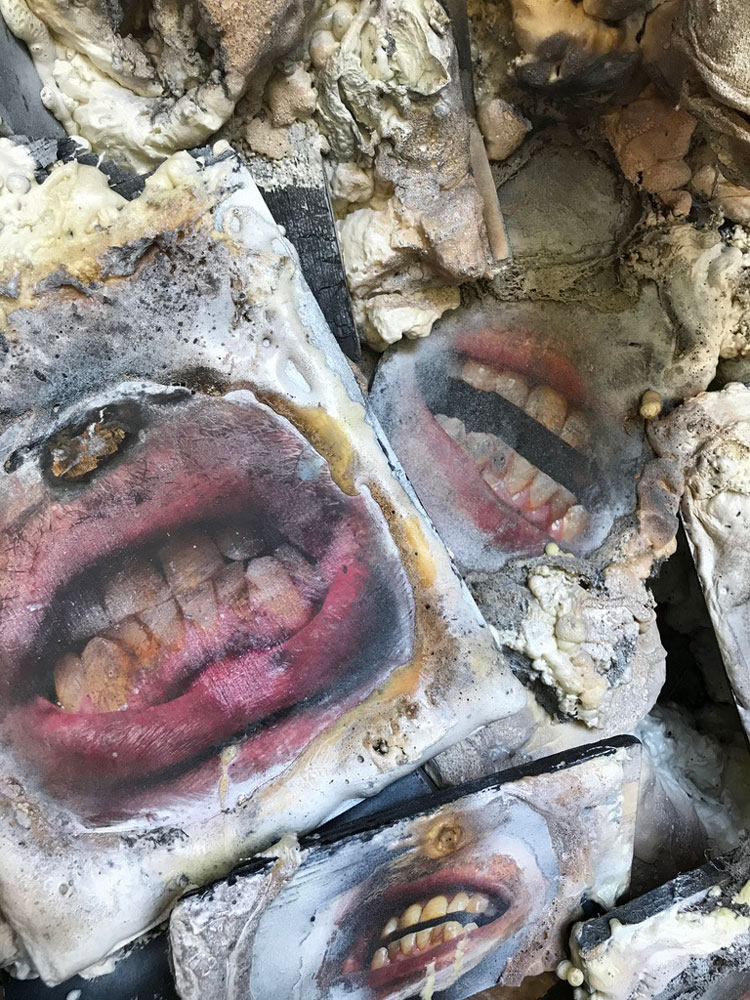
Tom de Freston. I Saw This, 2019-20 (detail). Courtesy the artist.
At the heart of the project is an attempt to translate Souleman’s internal world of memories into a highly charged body of paintings. Anguished mouths drowning amid turbulent eruptions of spattered paint materialise across collaged fields of burnt and charred wooden boards. Acrid concoctions of cadmium-red oil colour and resin-based mediums combine with concrete powder and fast-drying gloss to create fractious, volatile surfaces; splitting and cracking, they reveal teeth, lips and gaping voids. Augmenting Souleman’s written memoirs, they make visible his unseen experiences, expressing in paint things that are unable to be spoken.
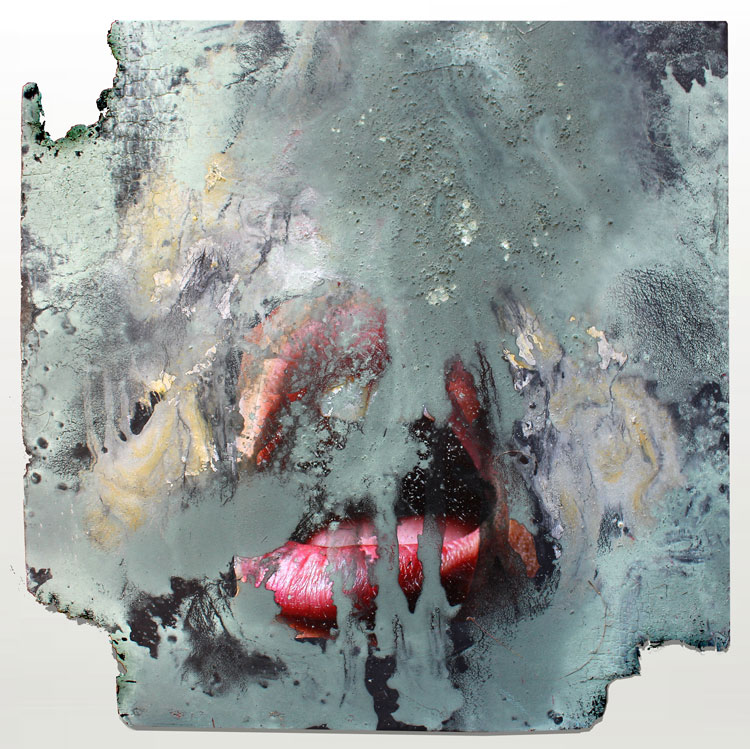
Tom de Freston. Study for I Saw This, 2019-20. Courtesy the artist.
Earlier this year, catastrophe struck: fire raged through De Freston’s studio, destroying all his work, including his collaborations with Souleman. Yet, as he explains in this interview, the tragedy has not dampened his resolve; though he lost everything, he remains curiously optimistic, determined to turn the devastation on its head and transform the charred remnants into something new. In addition to his collaborative work with Souleman and its subsequent destruction, he also discusses the recurring theme of trauma in his work and his forthcoming non-fiction book Wreck: The Art of Being Lost at Sea (Granta, 2021), in which he explores his obsession with Géricault’s Raft.
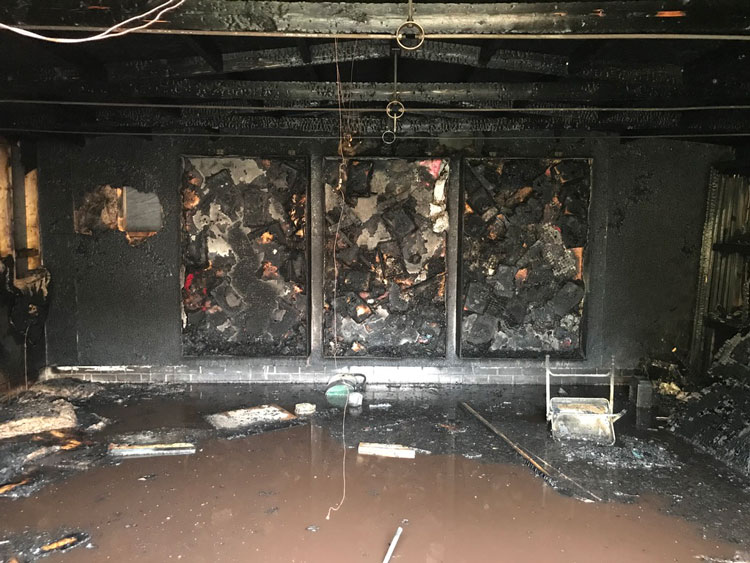
The aftermath of the fire at de Freston's studio, 2020.
David Trigg: Much of your work addresses trauma and how this might be represented in paint. What initially drew you to this subject?
Tom de Freston: Other people noticed this as a consistent theme in my work long before I did. Looking back at past projects, it’s clear I am interested in trauma – how it exists in historical and geopolitical contexts, in myth and literature, in poetry, in nature and in the individual. Though I hate the idea of any personal trauma being relevant, I have come to terms with the fact that my own experiences have driven me towards this theme. This doesn’t mean there is a simple causal relationship between my own suffering and how it manifests in my work, it’s more complex than that; it’s a primal driver, outside of my control. My work isn’t just about suffering though. I’d like to think there is beauty and hope in there too, and the possibility of transcendence and survival.
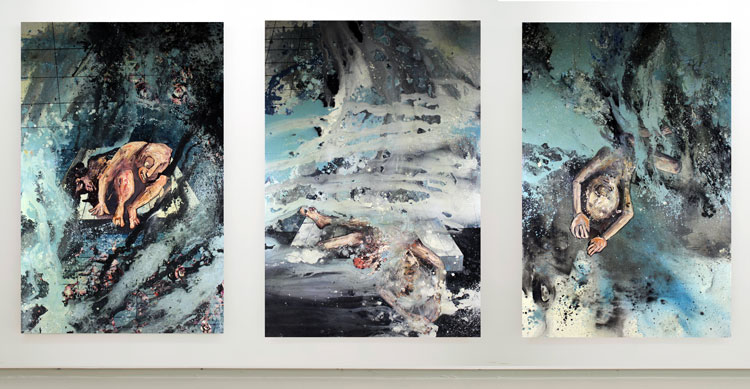
Tom de Freston. Poor Tom, 2015. Image courtesy the artist.
DT: Your most recent project, I Saw This, is a collaboration between you and Professor Ali Souleman, a Syrian academic at the University of Oxford who lost his sight during a terrorist attack in 1997. How did you meet him?
TdF: In 2015, I was working on my Poor Tom series with another Oxford academic, Professor Simon Palfrey, and the film-maker Mark Jones. We were looking at parallels between King Lear and the Syrian civil war when Simon’s wife suggested we meet Ali, who had recently emigrated from Damascus to Oxford. We quickly became friends and over the next year explored lots of potential collaborations. He asked to see my paintings and we spent a few hours in my studio exploring two particular canvases through a mixture of touch and discussion. They were particularly personal works – images of myself and my wife, rescuing each other from a stormy abyss. Something in the iconography, in the idea of being saved, resonated with Ali. He also felt things in the painting’s surfaces that other people had never seen, or perhaps couldn’t see. We both arrived at the same idea simultaneously: to see if it might be possible to translate in paint the rich internal, unseen world of experiences, memories and trauma that Ali speaks of so eloquently. We also decided to involve Mark, as it seemed clear that the project would be as much, if not more, about the journey we went on – the conversations and processes that took place – as much as the work that was produced. So, everything has been filmed and documented from the start.
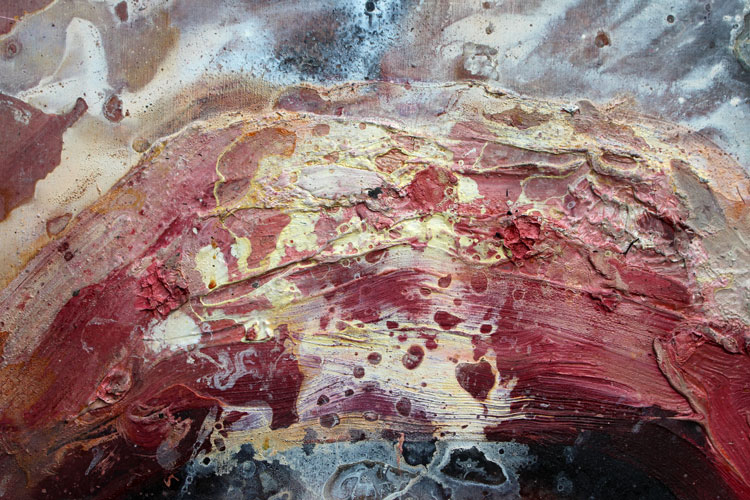
Tom de Freston. Study for I Saw This, 2019-20. Courtesy the artist.
DT: What were you hoping to achieve with the project?
TdF: At the heart of the project is an exploration of the possibility, or impossibility, of empathy – can we really see into, or feel, someone’s else’s experiences? What would be lost or damaged in the acts of translation that were going to take place – from Ali’s internal world to my canvas, and from the painting back to Ali’s attempt to see them? The main aim was to make work that felt true to Ali and for the process to be one that not only entered past wounds but also helped them to heal.
DT: Your painting process is very involved, often incorporating many layers of paint and collaged elements. Though still very much rooted in painting, these latest works verge on the sculptural.
TdF: After a year of working with Ali, I had produced quite a large body of work. But the paintings were failures. They were supposed to depict the drowned, mirror-world that Ali described himself entering as he descended into blindness after the bomb, but, instead, they had become about me and the grief that had accumulated since the death of my father in 2013. I burnt about 20 of those paintings, in order to let go of the past. The next morning, while sorting through the detritus, I realised I wanted to use the remains for the new works and that the fire could be a creative rather than destructive element in the process. I also realised that the paintings needed to be made explicitly for Ali, more sculptural and tactile. I began collaging different elements together – burnt surfaces, painted scraps, sheets and boxes – and built them up so they became like three-dimensional paintings exploding from the wall.
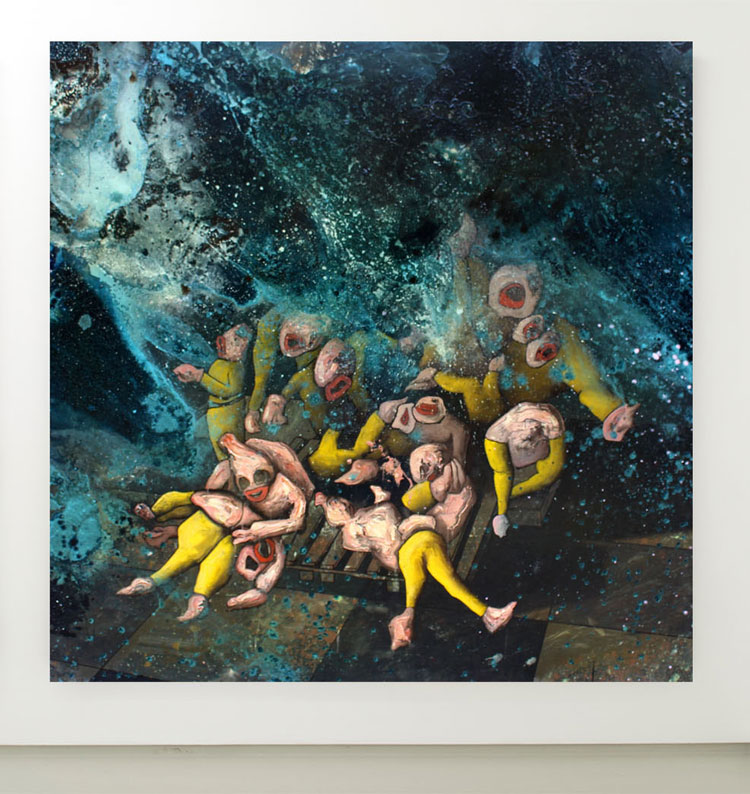
Tom de Freston. Demons Land, Book of Justice IV, 2017. Courtesy the artist.
DT: You often disrupt the surface of your paintings, but many elements in these works result from what appear to be some extremely volatile processes.
TdF: In trying to find a new language to convey Ali’s experience of entering his underworld of blindness, I used many new materials: expanding foam, resin, hair, burnt wood, rose petals, coffee, Perspex, broken mirrors and glass, printed images, tights, concrete and expanding wood glue. I also took photographs of Ali and myself and, after working paint directly into their surfaces, set them alight, turning the images into mask-like fragments. Using a blow torch and flammable liquids, I distorted, shifted and reconfigured these materials, looking to push the images to breaking point, making the work as much about what was destroyed and lost as what was left. The scarred and damaged surfaces became like sites of trauma.
DT: Was Souleman involved in the making process?
TdF: It was a constant conversation. I knew from the beginning that Ali couldn’t just be a subject, that the project couldn’t just be me trying to illustrate his experiences in paint. He posed for me and was physically involved in various aspects of the making. He also provided a huge amount of resources in regard to research, and offered thoughts on all the studies I made. But, ultimately, it was about friendship, about us building trust in each other.
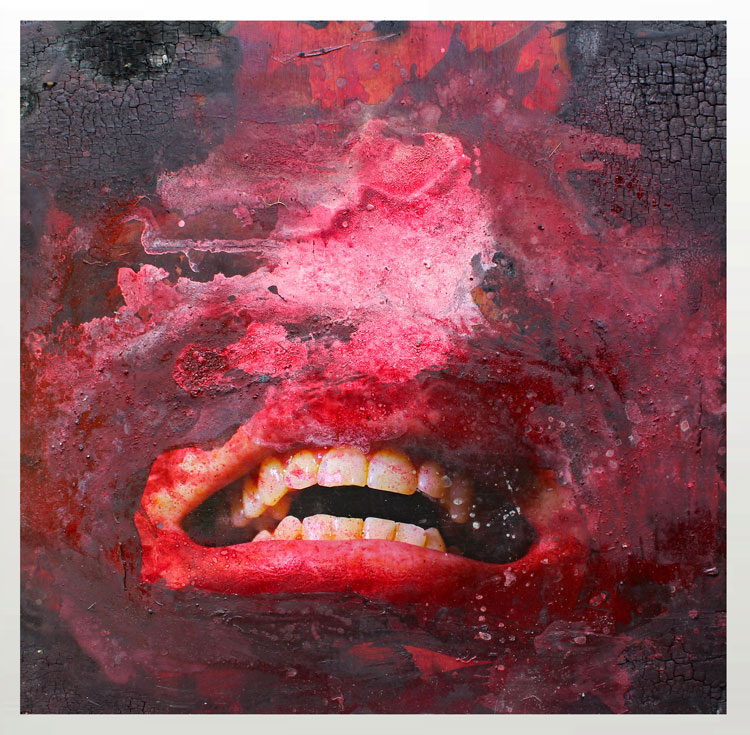
Tom de Freston. Study for I Saw This, 2019-20. Courtesy the artist.
DT: The new paintings look very tactile. Was this deliberate?
TdF: Touch is how Ali “sees” the paintings, so tactility was paramount. There is an acceptance of certain things being beyond Ali’s reach, such as colour and imagery, but he engages with the painting’s structures and surfaces in ways that no other viewer can, so the works contain a shared private language that no one else can access.
DT: Tragically, the works we are discussing were destroyed by a fire that gutted your studio in March. That must have been a terrifying experience.
TdF: All the work I had produced over the last few years was stacked up around the room, from floor to ceiling – Ali and Mark were coming the next day for an unveiling of sorts. I had just finished the final triptych, but my manic compulsion made me fiddle a bit more with the blowtorch and the surface caught fire. I tried to blow it out, then pat it out, then chuck water at it. The mass of flammable materials meant it started spreading vertically very quickly. I grabbed the fire extinguisher, pointed and squeezed, but it didn’t work. I desperately tried to rip the whole structure off the wall, but it wouldn’t budge. By this point, the whole back wall was up in flames. I turned to get out and the studio was filled with plumes of black smoke. I was very lucky to escape. I was filled with pure terror and panic, convinced the fire might spread to neighbouring houses. The entire studio was a glowing furnace. The fire brigade arrived in five minutes. They were incredible. It took them a few hours to be able to put the fire out as the space was a tinderbox of flammable materials. I knew at that point that nothing inside would survive.

Tom de Freston's studio on fire. Courtesy the artist.
DT: You lost everything?
TdF: Everything I had made for the project with Ali was destroyed, along with about 50 other large paintings – works from every project over the last 12 years. I think I would be completely broken if it hadn’t been for Mark’s film. Somehow, the fact that the making of the work and its subsequent loss has been documented makes it easier to swallow. One of the first things I did the day after the fire was call Mark so he could document the aftermath. That felt like a key part of the grieving process. A few days later, he filmed me showing Ali the burnt-out studio. The remains of the triptych was a particularly hard thing to show him. Most of the paintings were completely lost, but because the triptych is so sculptural it has been more transformed than destroyed. The burnt-out structure looks very much like an aerial photograph of the damage inflicted on cities such as Aleppo and Damascus. It felt like the fire had unwittingly created the cruellest mirror of Ali’s worst experiences.
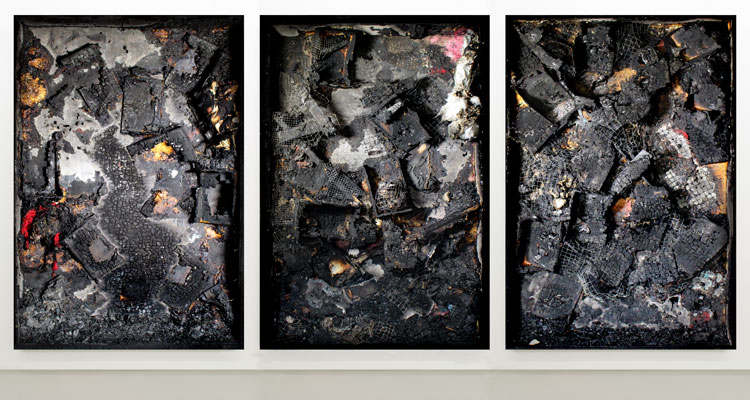
Tom de Freston. I Saw This after the fire. Courtesy the artist.
DT: Many artists might have felt like giving up after losing so much, but you mentioned that you are feeling strangely optimistic.
TdF: The way I processes grief and trauma has always been to explore and translate. That’s the way I survive. I don’t want to trivialise the fire, or to perpetuate cliches of events like this having silver linings – I lost a vast amount of work and still feel in shock. But I feel as if I am seeing and thinking more clearly, as if my attention has been heightened and focused. The loss is hard to carry but, when I think forwards, I am so excited about how this event will change my work. I have always repurposed materials and found possibilities in destruction, so in this sense the fire is a gift. I have kept everything and when I am able to start working again, I am going to use all the damaged materials to make new, even stronger work.
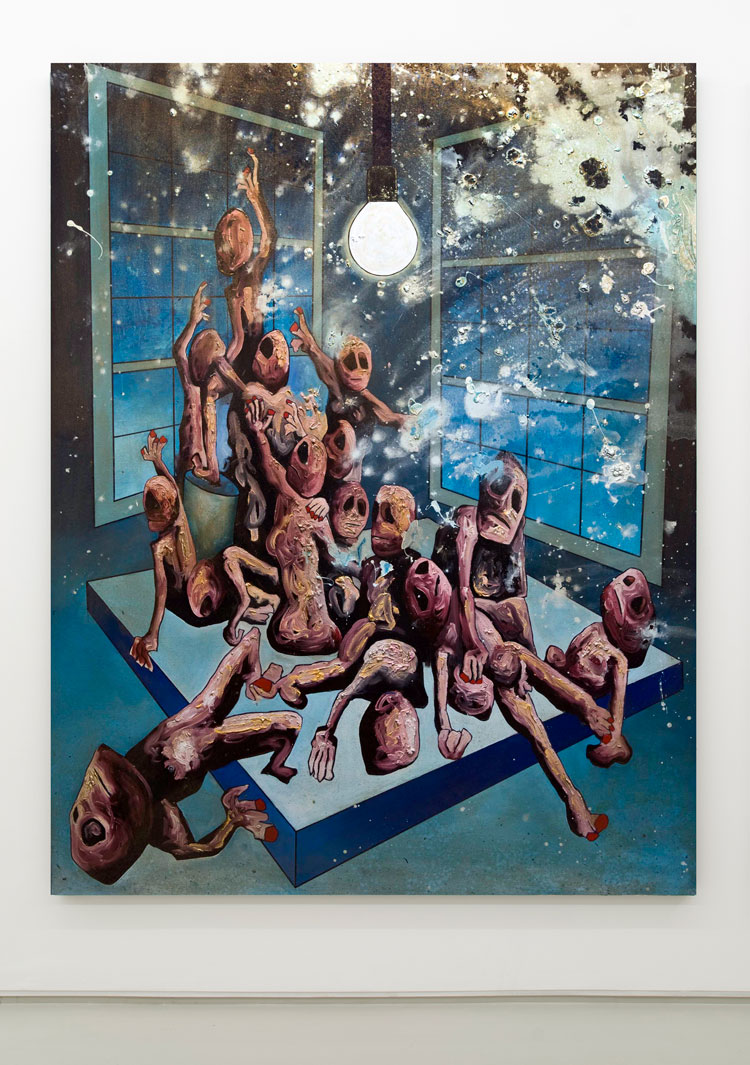
Tom de Freston. Raft, 2014. Courtesy the artist
DT: Tragedy has long played a significant role in your work. Géricault’s The Raft of the Medusa, with its brutal portrayal of pain and suffering, has been a particular preoccupation of yours for several years. What first attracted you to this masterpiece of French Romanticism?
TdF: It was in 2003, while studying for my fine art degree at Leeds Metropolitan University, that I took a trip to France. I remember walking around the Louvre feeling completely lost and overwhelmed, suddenly aware of how little I knew. Then something in that painting caught my attention, the noise fell away and I was transfixed. It seemed like an image you could fall into and be transported away to new worlds. That experience contributed towards a feeling that my practice was lost, that I needed a firmer foundation in the history of painting, so that’s when I decided to apply to Cambridge to study history of art. I remember seeing Géricault’s Raft again in a lecture and that was the spark of an obsession with the image. I had this weird, dizzy feeling that the painting was somehow the anchor on which hung a whole load of things I had been magnetically drawn to since my teenage years: Keats’s spring odes, Mark E. Smith’s The Fall, Thomas Tallis, Titian’s poesie, King Lear and more. Since then, I have been back to Paris to see it about 10 times.
DT: Your relationship with Géricault’s painting, which has informed many of your own works, is explored in your forthcoming non-fiction book Wreck: The Art of Being Lost at Sea. How did this project get started?
TdF: In 2015, I was approached by a literary agent after giving a talk about the emergence of the personal in my work, particularly the presence of grief. She asked if I had thought about writing a book connected to the subject. I had long wanted to write something that grappled with the ways in which trauma can exist in painting, and the Raft paintings I had been making after my dad died felt pivotal to this. Over the next few years I worked with a few agents, but I was still in the grips of mental ill health and I lacked the craft, conviction and confidence that was needed. I was close to giving up when a few very trusted writer friends, including my wife [the novelist Kiran Millwood Hargrave], made me realise I had no choice but to write it. So, I put the idea of publishing on hold and just focused on the writing. Then I found my current agent, the brilliant Harriet Moore, without whom the book could never have got into a state to pitch to publishers. To be published by Granta and edited by Bella Lacey is the stuff of dreams.
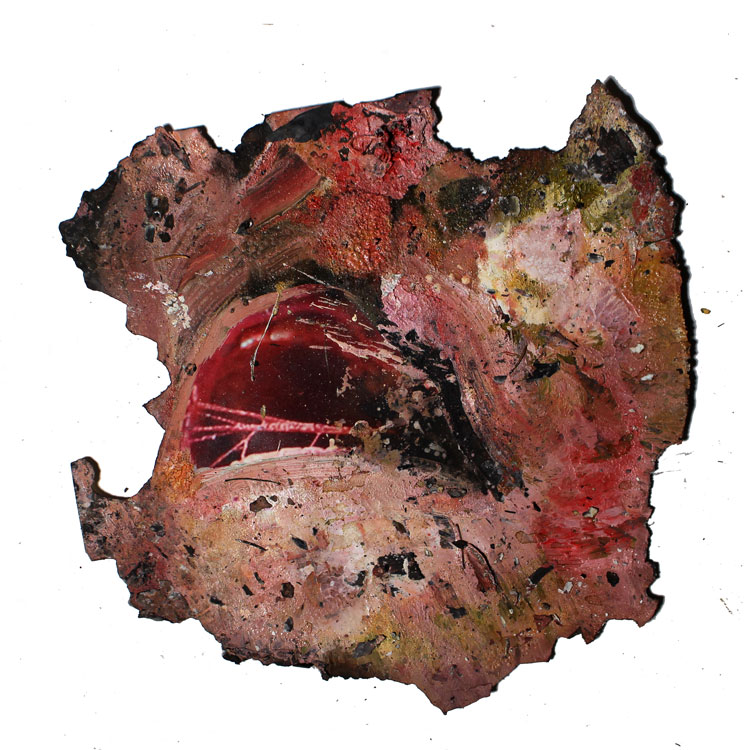
Tom de Freston. Detail from Truthtellers, 2017. Courtesy the artist.
DT: To what extent do you consider writing a part of your artistic practice?
TdF: It’s critical because it provides a different way into and out of the problems I deal with when I’m painting. Writing provides a way for me to think through painting in a very different way to the explorations that take place in the studio. They are different languages, but everything always comes back to painting.
DT: Wreck is a very autobiographical book; it addresses the difficult relationship you had with your father, particularly your experiences of grief in the wake of his death.
TdF: Writing this book has been crippling at points. I am still completely unsure of it, worried about cliche, about being too vulnerable or exposed, about expressing things that are not mine to express, or that are beyond my capabilities. In truth, I am very scared of this book. But I think that’s a good thing. It has certainly been key in helping me address things from my past, both personally and creatively, and has encouraged me to not turn away from the darkness of the unknown, but to confront it.
DT: How have those personal experiences of loss and grief fed into your painting practice?
TdF: In ways which are still too complex for me to easily articulate. Personal loss has stripped away a lot of my arrogance and forced me to look, think and make more attentively, to truthfully question what it is I am doing. It has helped me to be more honest and vulnerable. My work has always been about mourning, and I think painting is well placed to deal with this. Painting by its very nature is an act of mourning; its surfaces are full of histories, layers of time and littered with ghosts.
DT: What impact has the experience of losing your studio and so much of your work had on the book?
TdF: It has transformed it. It had to really. Just as it will have to completely transform my painting practice. I have restructured the whole book, so now my dad’s death and the fire provide two tent poles at either end of an eight-year narrative. It has cleared out a lot of dead wood in the book and made me think with more clarity and focus.
DT: Not only have you lost your studio, but now, because of Covid-19, you are in lockdown along with the rest of the country, which must be making it even more difficult to paint.
TdF: I was due to be in Australia now, as part of a collaboration with Indigenous artists and art centres, so it’s strange to now be in lockdown at home in Oxford. Because the studio was destroyed, I can’t paint at the moment. I have barely gone a day without painting for the last 12 years, so I thought I would find this period impossible. But I have instead been able to focus all my energies on the book. Spending time away from painting has allowed me to reflect and think really carefully about what it is I want to do when I return to the studio. Losing 12 years’ worth of work very quickly focuses the mind.
Film by Mark Jones / Unmarked Films